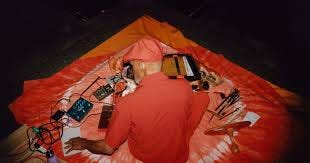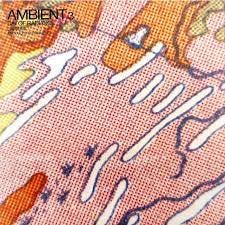Music is vibration – the alchemy that happens when breath moves through tubes and strings resonate as they’re plucked, and all the rest.
Some people are better at moving the molecules around than others. Edward Larry “Flash” Gordon, better known as Laraaji, is one of them.
The 79-year-old musician, meditation facilitator and laughter therapy pioneer approaches music as energy, a resource to be respected and cultivated. He plays zither and koto, synthesizer and thumb pianos like mbira and kalimba, often through effects pedals, and he works in a deliberate way with their sounds to cultivate a deep, spirit-centered receptivity in his listeners. Most music that’s marketed as “ambient” aims for the soothing pleasantries of the resort spa; his music coaxes more active engagement.
Laraaji, who was born in Philadelphia and has spent much of his professional life in New York, has been at it a while. A new compilation from the reissue specialists at Numero Group, Segue To Infinity, gathers his 1978 debut Celestial Vibration and six previously unissued studio explorations from around the same time, each lasting an LP side. The set documents the early period of Laraaji’s journey, when, as he recalled in an interview with Pitchfork, he began to seek the healing properties of sound.
“I said, “Here’s something I want to do with music: I want to be able to stimulate consciousness, to move beyond congestion and lower dimensions, and experience this open, eternal unity space.”
To trigger changes in consciousness through atmospheric, almost imperceptible changes in sound is an art, and like any other it requires repeated effort. The pieces on Segue to Infinity capture Laraaji – who played guitar in R&B bands and has recorded synthesizer landscapes and improvisations for solo piano – exploring the modulation of static harmony over time. You get the sense he attempted inquiries into these moods over and over again, arriving at differently shaped journeys on different days. Some pieces have distinct structures and recurring phrases that could be considered “hooks.” Some shift between several tonal centers. Some are plain, some swell up in the direction of grandeur.
All sound alive.
I’d argue that’s directly attributable to Laraaji’s musicianship – in particular, his sensitivity to the contours and behaviors of individual tones, which mirrors the articulation skills of the elite orchestral ninjas. A master of the tactile, he begins notes with a clear attack. He already knows how – and how long – each note will sustain, and when it will brush up against other notes, and how it will recede into the ether. His articulation on the koto and zither is dazzlingly crisp: Though they’re stringed instruments, they move as though animated by breath. Guitarists could learn stuff about strumming by listening to his voicings, the crystalline nature of his harmonic clusters.
Laraaji developed these instrumental techniques by busking in parks. Think about that – the longshot odds of creating anything in that situation. He’s set up on a sidewalk, surrounded by traffic sounds and people moving brusquely on their way. It’s New York so there’s not exactly an expansive sense of space. And, he’s not shredding anything to grab attention; sometimes the musical content he’s offering is a single note. And he’s focused on that detail, those singular details, in ways that, despite the setting, actually manage to reach others.
One of them was Brian Eno. In 1978, Eno heard Laraaji in Washington Square Park in lower Manhattan, and left a business card in his zither case. The two conversed for several hours the next day, and in short order Eno was producing the first Laraaji record to see wide international release: Ambient 3: Day of Radiance (1980). It remains a landmark.
Since then, Laraaji has followed his instincts through an impressively diverse range of audio projects – some captured on short-run cassettes, some on big labels, some existing mainly as rumors in a strange scattered discography. He’s offered intricate loop-like constructions that become hypnotic over time, presaging some instrumental EDM; he’s made chant-based devotional synth pop (Vision Songs Vol. 1) and then transformed some of its shorter pieces into transfixing extended mantras (check out the vivid 40-minute “Om Namah Shivaya,” which appears as its own album in streaming catalogs).
And those who are worried about AI and its potential to change (destroy?) art could get a chillout assist from Laraaji’s 2022 Meditation: You Are Relaxed. It’s a collaboration between the multi-instrumentalist and the “sound wellness” company Endel, which uses AI algorithms to create soothing music based on things like heartrate and atmospheric conditions. The 15-track work centers on Laraaji’s plinking percussion and open, spacious environments; the AI “responds” to his input with swirls of synthesized sound that’s apt and appropriately deferential. It could be any generic ambient tool for breathwork, except for the calm presence of Laraaji, a beam of humanity in a river of code.
Yes, we have a fancy digital suggestion box. Share your favorite Underloved/Overlooked records here: echolocatormusic@gmail.com.
Please consider subscribing (it’s still free!). And…..please spread the word! (This only works via word of mouth!)








He's amazing! I got quite a thrill a few years ago when I saw Jonathan Wilson on the Rare Birds tour and Laraaji appeared with him to play his part on Loving You: https://youtu.be/sBKnvy8cr80. He was a joyful presence who added a touch of additional magic to the night.